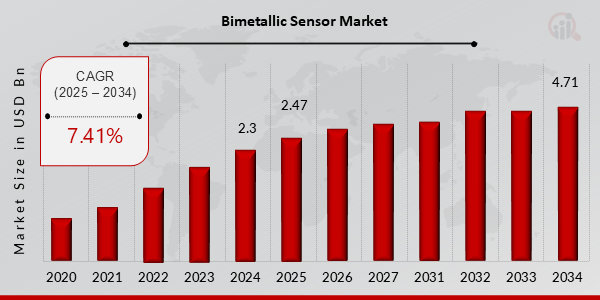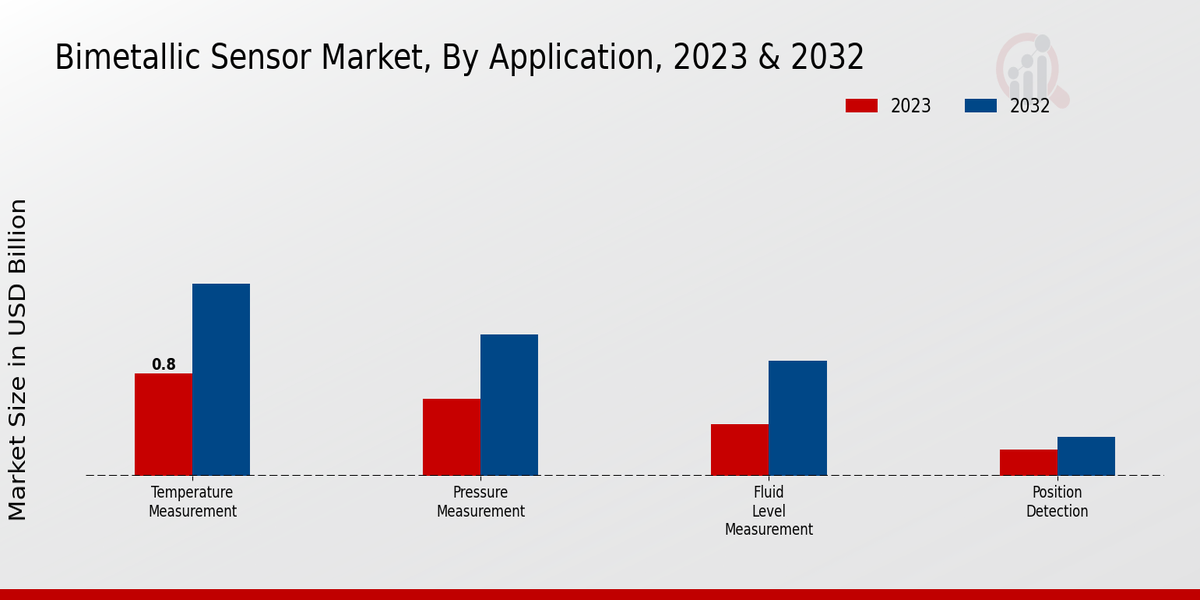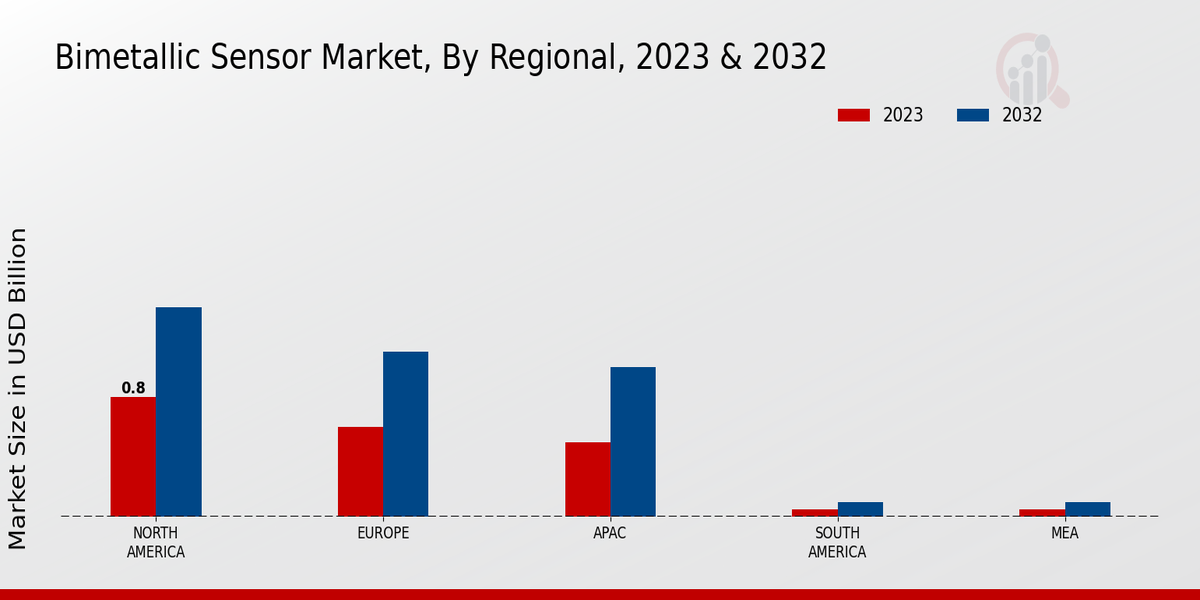Global Bimetallic Sensor Market Overview
Bimetallic Sensor Market Size was estimated at 2.30 (USD Billion) in 2024. The Bimetallic Sensor Market Industry is expected to grow from 2.47 (USD Billion) in 2025 to 4.71 (USD Billion) till 2034, exhibiting a compound annual growth rate (CAGR) of 7.41% during the forecast period (2025 - 2034).
Key Bimetallic Sensor Market Trends Highlighted
The Bimetallic Sensor Market is experiencing notable growth driven by increased demand for precise temperature measurement across various industries. This demand is fueled by the rising need for energy efficiency and automation in manufacturing processes, as well as the growing adoption of bimetallic sensors in HVAC systems, automotive applications, and industrial equipment. Additionally, advancements in sensor technology are enabling more accurate and reliable performance, further propelling market growth.
Opportunities in this market are significant, particularly in the development of smart sensors that can integrate with IoT systems.These sensors offer enhanced data analytics capabilities and real-time monitoring, appealing to industries focused on predictive maintenance and operational efficiency. There is also potential for expansion into emerging markets where industrialization is on the rise, increasing the need for reliable temperature control solutions.
In recent times, there has been a noticeable trend toward miniaturization and increased functionality of bimetallic sensors. This trend aligns with the broader shift toward smaller, more efficient devices in various applications. Manufacturers are investing in research and development to innovate and improve sensor designs, making them lighter and more versatile.Additionally, sustainability efforts are influencing the choice of materials used in sensor production, with a focus on reducing environmental impact while maintaining performance standards. Overall, the Bimetallic Sensor Market is poised for continued evolution, driven by technological advancements and increasing industrial applications.

Source: Primary Research, Secondary Research, MRFR Database and Analyst Review
Bimetallic Sensor Market Drivers
Growing Demand for Energy Efficiency in Industrial Applications
The Bimetallic Sensor Market Industry is witnessing a surge in demand for energy-efficient solutions across various industrial applications. Industries are actively seeking to reduce energy consumption and improve operational efficiency, which has led to an increase in the adoption of advanced sensing technologies. Bimetallic sensors play a crucial role in monitoring and controlling temperature and pressure, enabling industries to optimize their processes and minimize energy wastage.As companies face increasing pressure to comply with stringent environmental regulations and sustainability goals, the need for reliable and precise measurement tools becomes paramount.
This growing focus on energy efficiency is driving investments in bimetallic sensing technologies, propelling growth in the Bimetallic Sensor Market. The trend towards automation and digitization in industrial environments further complements this driver, as integrated systems require accurate data to perform effectively.Therefore, the emphasis on energy efficiency is expected to continue to be a significant market driver, promoting innovation and product development in the bimetallic sensor sector.
Rise in Automation Across Various Industries
The Bimetallic Sensor Market Industry is significantly benefiting from the increasing automation across various sectors, including manufacturing, automotive, and process industries. Automation requires precise sensing solutions to ensure optimal performance and reliability of systems. Bimetallic sensors, with their ability to measure temperature and pressure accurately, are essential components in automated systems. As industries adopt smart technologies and IoT solutions, the demand for advanced sensors is expected to rise, thus driving the growth of the market.The shift towards Industry 4.0 is further amplifying this trend, as manufacturers seek to enhance productivity through the integration of automated solutions.
Expanding Applications in Healthcare and Medical Devices
The Bimetallic Sensor Market Industry is experiencing growth due to the expanding applications of bimetallic sensors in healthcare and medical devices. These sensors are integral in monitoring critical parameters such as temperature in medical equipment and devices. With the increasing focus on patient safety and the rise of telemedicine, there is a growing need for reliable and accurate sensing solutions. The healthcare sector's evolution towards more personalized and data-driven approaches in treatment makes the integration of bimetallic sensors vital for advancements in medical technology.This growing demand will contribute to the overall expansion of the market.
Bimetallic Sensor Market Segment Insights
Bimetallic Sensor Market Application Insights
The Bimetallic Sensor Market, specifically within the Application segment, is projected to reach a valuation of 2.0 USD Billion in 2023 and shows potential for significant growth, expected to expand towards 3.8 USD Billion by 2032. This segment of the market is driven by various applications such as Temperature Measurement, Pressure Measurement, Fluid Level Measurement, and Position Detection, which play critical roles across multiple industries including manufacturing, automotive, and aerospace. Among these applications, Temperature Measurement holds a majority position, valued at 0.8 USD Billion in 2023 and anticipated to grow to 1.5 USD Billion by 2032, reflecting its essential function in processes requiring precise thermal control and management.
The Pressure Measurement application also plays a significant role, with a valuation of 0.6 USD Billion in 2023, expected to rise to 1.1 USD Billion in 2032, which is vital for ensuring safety and efficiency in systems such as HVAC and process control. Fluid Level Measurement stands at 0.4 USD Billion in 2023, growing to 0.9 USD Billion by 2032, emphasizing its importance in industries where monitoring liquid levels is crucial for operational reliability. Position Detection, while comparatively smaller, with a valuation of 0.2 USD Billion in 2023 and 0.3 USD Billion in 2032, still holds relevance in automation and robotics.The growth in this sector is attributed to advancements in technology, raising demand for precise monitoring and control solutions, which enhance efficiency, safety, and productivity in various industrial applications.
Moreover, challenges revolve around the integration of these sensors with existing systems and the need for constant updates in technology to keep pace with evolving demands. Nonetheless, the opportunities for innovation and expansion in manufacturing and industrial automation sectors continue to drive the Bimetallic Sensor Market growth.Overall, the Bimetallic Sensor Market statistics reveal critical insights into how the Application segment contributes significant value across a spectrum of industrial applications, underlining its importance in facilitating advancements and improving performance in real-world scenarios.

Source: Primary Research, Secondary Research, MRFR Database and Analyst Review
Bimetallic Sensor Market Type Insights
The Bimetallic Sensor Market is expected to achieve a valuation of 2.0 USD Billion by 2023, reflecting steady growth in the industry with diverse applications. The market segmentation for this domain includes various types, such as Thermometers, Pressure Sensors, Level Sensors, and Switches, all playing significant roles in different sectors. Thermometers account for a considerable share, driven by the need for precise temperature measurements in industrial and consumer applications. Pressure Sensors also represent a vital component, essential in monitoring and controlling various processes, thus making them a dominant force in the market.
Level Sensors are increasingly utilized in automation processes, contributing to operational efficiency and safety across industries. Switches, which are critical in controlling electrical circuits, emphasize reliability and effectiveness, catering to a wide range of industrial requirements. The anticipated market growth is fueled by advancements in technology and an increasing demand for automation, while challenges include competition and the need for continuous innovation. The Bimetallic Sensor Market data reflects a trend towards smart sensor technology, providing numerous opportunities for stakeholders.This landscape positions the market for robust development as the demand for accurate and reliable sensors continues to rise.
Bimetallic Sensor Market End Use Industry Insights
The Bimetallic Sensor Market is projected to reach a valuation of 2.0 USD Billion in 2023, showing strong potential within the End Use Industry segment. The market is experiencing growth driven by increased demand for precision measurement and control in various applications. Automotive applications play a crucial role, as bimetallic sensors are integral for temperature measurements in vehicles, contributing to enhanced fuel efficiency and emissions control. The Aerospace sector also holds significance, leveraging these sensors for critical safety applications in aircraft systems.In the Oil and Gas industry, bimetallic sensors provide reliable performance in extreme conditions, ensuring accurate monitoring of temperature and pressure, which is vital for operational safety.
Manufacturing processes benefit by utilizing these sensors to maintain optimal conditions, thereby facilitating production efficiency. The overall dynamics of the Bimetallic Sensor Market segmentation reflect a favorable growth outlook, driven by technological advancements and the steady shift toward automation across industries. Meanwhile, factors like increasing regulatory standards around equipment safety and product reliability further underscore the market's importance in these end use sectors.As such, the Bimetallic Sensor Market data demonstrates promising growth opportunities across these key industries.
Bimetallic Sensor Market Technology Insights
The Bimetallic Sensor Market is expected to experience notable growth within the Technology segment, showcasing a market value of 2.0 billion USD in 2023 and projected to reach 3.8 billion USD by 2032. The market is characterized by various types of sensors, with each type playing a crucial role in diverse applications. Analog sensors are highly valued due to their simplicity and reliability in providing continuous readings, making them essential in precision measurement applications. Digital sensors leverage advanced technology for enhanced accuracy and data transmission, catering to the growing demand for smart solutions.
Wireless sensors are becoming increasingly important, facilitating remote monitoring and data collection, which aligns with the rising trend of Internet of Things (IoT) integration across industries. The combination of these sensor types contributes significantly to the overall bimetallic sensor market performance, driven by technological advancements and increasing industrial automation, while the segment's strong growth is supported by the expanding adoption of smart technologies.
Bimetallic Sensor Market Regional Insights
The Bimetallic Sensor Market revenue is poised for notable growth across various regions. In 2023, North America leads with a valuation of 0.8 USD Billion, reflecting the region's majority holding due to its advanced technological infrastructure and high demand from industries such as automotive and HVAC. Europe follows with a valuation of 0.6 USD Billion, benefiting from a strong focus on energy efficiency and regulatory support for innovative sensor technologies.
The APAC region, valued at 0.5 USD Billion in 2023, represents a significant growth opportunity driven by rising industrialization and an expanding manufacturing base.South America and MEA, each valued at 0.05 USD Billion, are emerging markets with potential, but currently they hold the least share in the Bimetallic Sensor Market. The overall market growth in these regions is influenced by trends in automation, increased demand for accurate temperature measurement, and efforts to enhance energy efficiency.

Source: Primary Research, Secondary Research, MRFR Database and Analyst Review
Bimetallic Sensor Market Key Players and Competitive Insights
The Bimetallic Sensor Market is characterized by substantial competition, driven by technological advancements and increasing demand across various industries. Bimetallic sensors are predominantly used in temperature measurement and control applications, leveraging the differential expansion of two metals to provide accurate readings. As industries strive to enhance operational efficiency and safety, the need for reliable temperature sensing solutions has burgeoned, leading to a dynamic market landscape where various players are vying for market share. The competitive insights reveal a mix of well-established companies and emerging innovators, all focusing on product differentiation, superior technology, and comprehensive customer service to gain a foothold in this rapidly evolving sector.Vishay Intertechnology stands as a significant player in the Bimetallic Sensor Market, leveraging its extensive experience and technological expertise to offer a broad range of high-quality bimetallic temperature sensors.
The company's strength lies in its commitment to innovation and continuous improvement, allowing it to deliver products that meet diverse customer requirements across various industries. With a robust global presence, Vishay Intertechnology benefits from a well-established distribution network and strong brand recognition. This positioning not only facilitates customer access to their extensive product lineup but also fosters strong relationships with clients, enhancing customer loyalty. The reliability of Vishay Intertechnology's bimetallic sensors, accompanied by rigorous quality control measures, reinforces its competitive advantage in an increasingly discerning market landscape.
Omega Engineering also commands a notable position in the Bimetallic Sensor Market by offering a diverse range of temperature sensing solutions, including bimetallic sensors tailored for various applications. The company's strengths are rooted in its customer-centric approach, emphasizing the development of products that cater to specific industry needs, coupled with an expansive catalog that allows for customization and high adaptability. Omega Engineering's robust technical support and extensive resources empower customers to select and implement the most suitable bimetallic sensors for their operations. By focusing on delivering value through quality, technical excellence, and superior application support, Omega Engineering establishes itself as a trusted partner in the bimetallic sensor domain, responding to the market's evolving demands with agility and precision.
Key Companies in the Bimetallic Sensor Market Include
- Vishay Intertechnology
- Omega Engineering
- KROHNE
- Bourns
- Monnit Corporation
- Honeywell
- Endress+Hauser
- Siemens
- SICK AG
- General Electric
- Emerson Electric
- ABB
- Parker Hannifin
- TE Connectivity
- Yokogawa Electric
Bimetallic Sensor Market Industry Developments
The Bimetallic Sensor Market has experienced significant shifts, characterized by innovations aimed at enhancing product performance and reliability. Companies like Vishay Intertechnology and Honeywell are leading developments by focusing on smart sensor technologies that integrate IoT capabilities. Additionally, Omega Engineering and Siemen's recent advancements in temperature sensing solutions have opened new avenues for application in various industries, including healthcare and manufacturing. Recent mergers have also influenced market dynamics, with KROHNE and Emerson Electric reportedly engaging in strategic partnerships to expand their market reach and technological capabilities.
The competitive landscape has intensified as Bourns and TE Connectivity enhance their product lines through R&D investments. The growth trajectory of the market is evident as these companies experience rising valuations, propelled by an increased demand for precision and reliability in automation processes. Current trends reflect an upward valuation in key companies, ultimately shaping the market's future by fostering greater innovation and efficiency in sensor technologies. Overall, these developments indicate a robust and evolving market landscape, driven by both technological advancements and strategic collaborations among leading players.
Bimetallic Sensor Market Segmentation Insights
-
Bimetallic Sensor Market Application Outlook
- Temperature Measurement
- Pressure Measurement
- Fluid Level Measurement
- Position Detection
-
Bimetallic Sensor Market Type Outlook
- Thermometers
- Pressure Sensors
- Level Sensors
- Switches
-
Bimetallic Sensor Market End Use Industry Outlook
- Automotive
- Aerospace
- Oil and Gas
- Manufacturing
-
Bimetallic Sensor Market Technology Outlook
- Analog Sensors
- Digital Sensors
- Wireless Sensors
-
Bimetallic Sensor Market Regional Outlook
- North America
- Europe
- South America
- Asia Pacific
- Middle East and Africa
|
Report Attribute/Metric
|
Details
|
|
Market Size 2024
|
USD 2.30 Billion
|
|
Market Size 2025
|
USD 2.47 Billion
|
|
Market Size 2034
|
USD 4.71 Billion
|
|
Compound Annual Growth Rate (CAGR)
|
7.41% (2025-2034)
|
|
Base Year
|
2024
|
|
Market Forecast Period
|
2025-2034
|
|
Historical Data
|
2020-2023
|
| Market Forecast Units |
USD Billion |
| Key Companies Profiled |
Vishay Intertechnology, Omega Engineering, KROHNE, Bourns, Monnit Corporation, Honeywell, Endress+Hauser, Siemens, SICK AG, General Electric, Emerson Electric, ABB, Parker Hannifin, TE Connectivity, Yokogawa Electric |
| Segments Covered |
Application, Type, End Use Industry, Technology, Regional |
| Key Market Opportunities |
Rising demand in HVAC systems, Expansion in automotive applications, Growth in industrial automation, Increasing focus on safety standards, Advancements in sensor technology |
| Key Market Dynamics |
Increasing demand for automation, Growing consumer electronics sector, Advancements in sensor technology, Rising focus on energy efficiency, Expanding automotive applications |
| Countries Covered |
North America, Europe, APAC, South America, MEA |
Frequently Asked Questions (FAQ) :
The Bimetallic Sensor Market is expected to be valued at 4.71 USD Billion in 2034.
The expected CAGR for the Bimetallic Sensor Market from 2025 to 2034 is 7.41%.
The Temperature Measurement segment is projected to reach a market value of 1.5 USD Billion by 2032.
The Pressure Measurement application is valued at 0.6 USD Billion in 2023.
North America is expected to dominate the market with a value of 1.4 USD Billion by 2032.
The APAC region is anticipated to reach a market value of 1.0 USD Billion by 2032.
Major players include Vishay Intertechnology, Omega Engineering, KROHNE, and Honeywell among others.
The Fluid Level Measurement segment is valued at 0.4 USD Billion in 2023.
The Position Detection application is expected to have a market size of 0.3 USD Billion in 2032.
South America is projected to have a market size of 0.1 USD Billion by 2032.

















